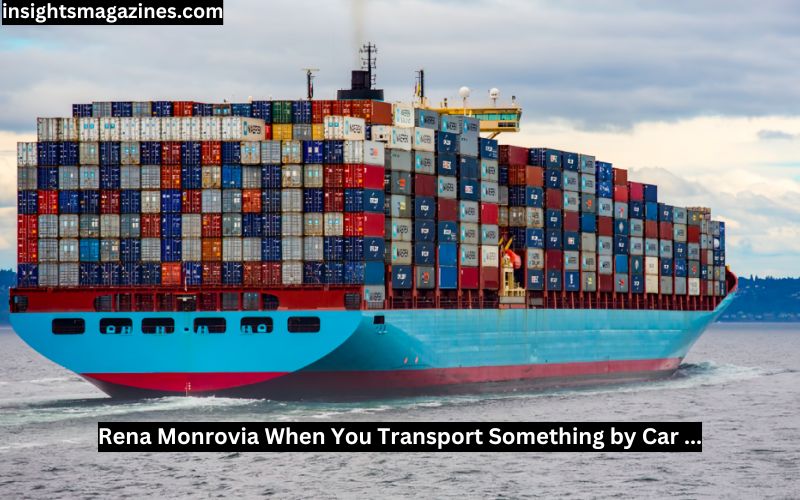Rena Monrovia When You Transport Something by Car … Transporting goods by car is a common necessity for individuals and businesses alike. Whether you are moving your belongings to a new home, delivering products to customers, or simply transporting items from one location to another, understanding the best practices for safe and efficient transportation is essential. This article will delve into various aspects of transporting goods by car, focusing on tips, strategies, and important considerations to ensure a smooth process. We’ll also explore the role of Rena Monrovia in this context and how her insights can guide you in transporting items effectively.
Understanding the Importance of Safe Transport
The Significance of Proper Transport
When you transport something by car, safety is the primary concern. Properly securing and organizing your goods helps prevent damage during transit and reduces the risk of accidents. Moreover, safe transport ensures that your items arrive at their destination in the same condition they left.
Benefits of Safe Transport
- Damage Prevention: Securely transporting items minimizes the risk of breakage or loss.
- Time Efficiency: A well-planned transport reduces delays, ensuring timely delivery.
- Cost Savings: Avoiding damage means fewer costs related to replacements or repairs.
- Legal Compliance: Ensuring that items are transported in accordance with local laws prevents legal issues.
Psychological Peace of Mind
Ensuring that your items are safely transported also provides psychological peace of mind. Knowing that your belongings or products are secure allows you to focus on other aspects of your move or business operations without unnecessary stress.
Preparing for the Journey
Planning Your Route
Before hitting the road, it’s crucial to plan your route carefully. Factors like traffic patterns, road conditions, and weather can greatly affect your journey. Utilizing navigation apps can help you find the best routes and avoid potential obstacles.
Factors to Consider in Route Planning
- Traffic Patterns: Research common traffic issues along your route, such as construction zones or areas prone to heavy congestion.
- Road Conditions: Consider the type of roads you’ll be traveling on, whether they are highways or local streets. This can impact travel speed and safety.
- Rest Stops: Identify potential rest stops along your route where you can take breaks, refuel, or check on your cargo.
The Role of GPS Technology
GPS technology has revolutionized route planning. Many GPS systems and smartphone apps provide real-time traffic updates, helping you avoid congested areas and make informed decisions about your route. Some advanced systems even offer alternate routes based on current conditions, ensuring a smoother journey.
The Role of Rena Monrovia in Transporting Goods
Who is Rena Monrovia?
Rena Monrovia is a well-known expert in logistics and transport. Her extensive knowledge and experience have helped many individuals and businesses streamline their transport processes. By applying her strategies, you can enhance your own transport experiences.
Rena’s Tips for Efficient Transport
- Use Quality Packing Materials: Rena emphasizes the importance of sturdy boxes and protective materials to safeguard your goods.
- Label Everything: Clearly labeling boxes and items makes unpacking at the destination much easier.
- Create an Inventory List: Keeping track of all items being transported helps in identifying any missing goods after arrival.
Rena’s Approach to Risk Management
Rena also highlights the importance of risk management in the transportation process. By identifying potential risks, such as accidents or theft, and taking proactive measures to mitigate them, you can ensure that your transport goes as smoothly as possible.
Packing Techniques for Safe Transport
Best Practices for Packing
How you pack your items significantly impacts their safety during transport. Here are some packing techniques to consider:
Heavy Items First
Place heavier items at the bottom of the vehicle or packing boxes. This lowers the center of gravity, reducing the risk of tipping or rolling while driving.
Utilize Padding
Use blankets, bubble wrap, or foam inserts to cushion fragile items. This additional protection is vital for preventing breakage. Rena Monrovia suggests that you should not skimp on padding—investing in quality materials can save you money in the long run by preventing damage.
Secure Loose Items
Ensure that all items are secured in place, either with straps or by packing them tightly together. Loose items can shift during transport, causing damage or accidents.
Consider Temperature-Sensitive Items
If you are transporting items that are sensitive to temperature, such as food or certain electronics, it’s essential to consider the environmental conditions. Use insulated containers or temperature-controlled vehicles to keep these items safe.
Legal Considerations When Transporting Goods
Understanding Legal Regulations
Transporting goods often involves compliance with local and federal regulations. Understanding these regulations is crucial to avoid fines or legal trouble.

Required Documentation
- Bills of Lading: Essential for tracking goods in transit.
- Insurance Papers: Protect your goods in case of damage or theft.
- Permits for Special Cargo: Certain items may require special permits, such as hazardous materials.
Importance of Vehicle Registration
Ensure that your vehicle is properly registered and insured for the load you are carrying. Failure to comply with local vehicle regulations can lead to fines and legal complications.
Strategies for Long-Distance Transport
Preparing for Extended Journeys
When transporting goods over long distances, additional considerations come into play. Here are some strategies for long-distance transport:
Plan for Breaks
Schedule regular breaks during long drives to rest and assess the cargo. This helps maintain focus and ensures that the load remains secure. Consider using these breaks to stretch and refuel both the vehicle and yourself.
Monitor Weather Conditions
Stay informed about weather conditions along your route. Bad weather can pose serious risks, and it may be wise to adjust your schedule accordingly. Use reliable weather apps to get real-time updates and forecasts.
Emergency Preparedness
Prepare for emergencies by carrying an emergency kit that includes a first-aid kit, basic tools, water, snacks, and a flashlight. Having these items on hand can be invaluable in case of unexpected situations.
Using Technology for Transport Efficiency
Technology in Modern Transport
In today’s digital age, various technologies can aid in the transport of goods. Here’s how you can leverage them:
GPS and Navigation Tools
Using GPS and navigation apps can provide real-time traffic updates, helping you avoid congestion and delays. Some apps even allow for route optimization, suggesting the fastest path based on current traffic conditions.
Inventory Management Software
For businesses, utilizing inventory management software can streamline the packing and tracking process, ensuring nothing is overlooked. These tools often integrate with shipping and logistics platforms, providing a comprehensive view of your inventory during transport.
Communication Tools
Modern communication tools, such as messaging apps and project management software, can help keep all parties informed during the transport process. These tools facilitate real-time communication, ensuring that everyone is updated on the status of the shipment.
The Importance of Communication
Keeping Everyone Informed
Communication plays a key role in successful transportation. Ensure that everyone involved in the process is informed of timelines and expectations.
Regular Updates
Provide regular updates to clients or family members regarding the status of the transport. This builds trust and ensures everyone is on the same page. Establish a communication protocol that outlines who to contact and when.
Feedback Mechanism
Encourage feedback from everyone involved in the transport process. This allows you to identify areas for improvement and adjust your strategies for future transport efforts.
Handling Fragile and Valuable Items
Special Considerations for Fragile Goods
Transporting fragile items requires additional care and attention. Here are some tips for safely moving delicate goods:
Use Specialized Packing Materials
Invest in packing materials specifically designed for fragile items, such as custom boxes or foam inserts. These materials offer extra protection against shocks and vibrations during transit.
Clearly Mark Fragile Items
Label boxes containing fragile items with clear markings, such as “Fragile” or “Handle with Care.” This informs anyone handling the boxes to exercise caution, minimizing the risk of accidents.
Limit Movement
When loading fragile items, ensure they are packed tightly to limit movement during transport. Use dividers or packing peanuts to fill any gaps and create a snug fit.
Dealing with Unexpected Situations
Preparedness for the Unexpected
Despite careful planning, unexpected situations can arise during transport. Here’s how to deal with them effectively:
Flat Tires and Mechanical Issues
Have a roadside assistance plan in place and ensure you have the tools necessary for basic repairs, such as a spare tire, jack, and basic tool kit. Familiarize yourself with your vehicle’s manual to understand how to handle common issues.
Accidents and Emergencies
In case of an accident, prioritize safety by ensuring everyone involved is okay. Contact emergency services if necessary and document the scene for insurance purposes. Keeping a camera or your smartphone handy can help with this.
Lost or Misplaced Items
If items go missing during transport, consult your inventory list to identify what’s missing. If you have labeled boxes clearly, this process will be easier. Report any lost or stolen goods to local authorities and your insurance company.
Environmental Considerations in Transport
Eco-Friendly Transport Practices
As awareness of environmental issues grows, considering eco-friendly practices in transporting goods has become increasingly important. Here are some strategies for reducing your carbon footprint during transport:
Use Fuel-Efficient Vehicles
Opt for vehicles that offer better fuel efficiency. If you’re a business owner, consider investing in electric or hybrid vehicles for your fleet to minimize environmental impact.
Consolidate Shipments
Whenever possible, consolidate shipments to reduce the number of trips required. This not only saves fuel but also decreases traffic congestion and emissions.
Recycle Packing Materials
After your transport is complete, recycle packing materials where possible. Many materials can be reused or recycled, contributing to a more sustainable approach to transport.
See Also: insightsmagazines.com
Conclusion
Transporting goods by car involves careful planning, execution, and consideration of numerous factors. By implementing the tips and strategies discussed in this guide, you can enhance the safety and efficiency of your transport processes. Drawing inspiration from experts like Rena Monrovia can also provide valuable insights and best practices that further improve your transport efforts.
Ultimately, the goal is to ensure that your items arrive at their destination safely and efficiently, allowing you to focus on what truly matters, whether that’s moving to a new home, delivering products to customers, or simply transporting personal items. Safe travels and successful transport await you!




